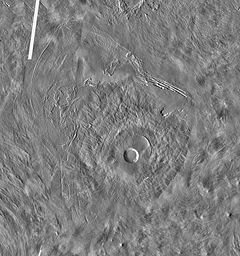Pavonis Mons

THEMIS daytime IR mosaic of Pavonis Mons. A large fan-shaped expanse of knobby deposits (the Pavonis Sulci) believed left by past glaciation extends northwestward from the mountain.
|
|
| Coordinates | 1°29′N 247°02′E / 1.48°N 247.04°ECoordinates: 1°29′N 247°02′E / 1.48°N 247.04°E |
|---|---|
| Peak | 8.7 mi (14 km/46,000 ft) |
| Discoverer | Mariner 9 (1971) |
| Eponym | Latin - Mount Peacock |
Pavonis Mons (Latin for "peacock mountain") is a large shield volcano located in the Tharsis region of the planet Mars. It is the middle member of a chain of three volcanic mountains (collectively known as the Tharsis Montes) that straddle the Martian equator between longitudes 235°E and 259°E. The volcano was discovered by the Mariner 9 spacecraft in 1971 and was originally called Middle Spot. Its name formally became Pavonis Mons in 1973.
Pavonis Mons stands at the southern edge of the Tharsis quadrangle - approximately 400 km southwest of Ascraeus Mons (the northernmost of the Tharsis Montes) and 400 km northeast of Arsia Mons (the southernmost member of the chain). The Tharsis Montes volcanoes lie along the crest of a northeast-trending rise (Tharsis bulge) that extends more than 3,000 km across the western equatorial region of Mars.Olympus Mons, the largest volcano in the Solar System lies at the edge of the Tharsis bulge, about 1,200 km northwest of Pavonis Mons.
Pavonis Mons is the smallest of the Tharsis Montes volcanoes, measuring about 375 km across and standing 14 km above Mars' mean surface level. As a shield volcano, Pavonis Mons has an extremely low profile with flank slopes that average only 4°. The summit contains a deep, circular caldera that is 47 km in diameter and almost 5 km deep. A larger, shallower depression lies immediately northeast of the smaller caldera. The large depression is about 90 km in diameter and structurally more complex than the small caldera.
Like most of the Tharsis region, Pavonis Mons has a high albedo (reflectivity) and low thermal inertia, indicating that the volcano and surrounding areas are covered with large amounts of fine dust (see Martian surface). The dust forms a mantle over the surface that obscures or mutes much of the fine-scale topography and geology of the region. Tharsis is probably dusty because of its high elevations. The summit experiences an atmospheric pressure of around 130 Pa (1.3 mbar), about 21% of Mars' mean surface pressure. The atmospheric density is too low to mobilize and remove dust once it is deposited.
...
Wikipedia
